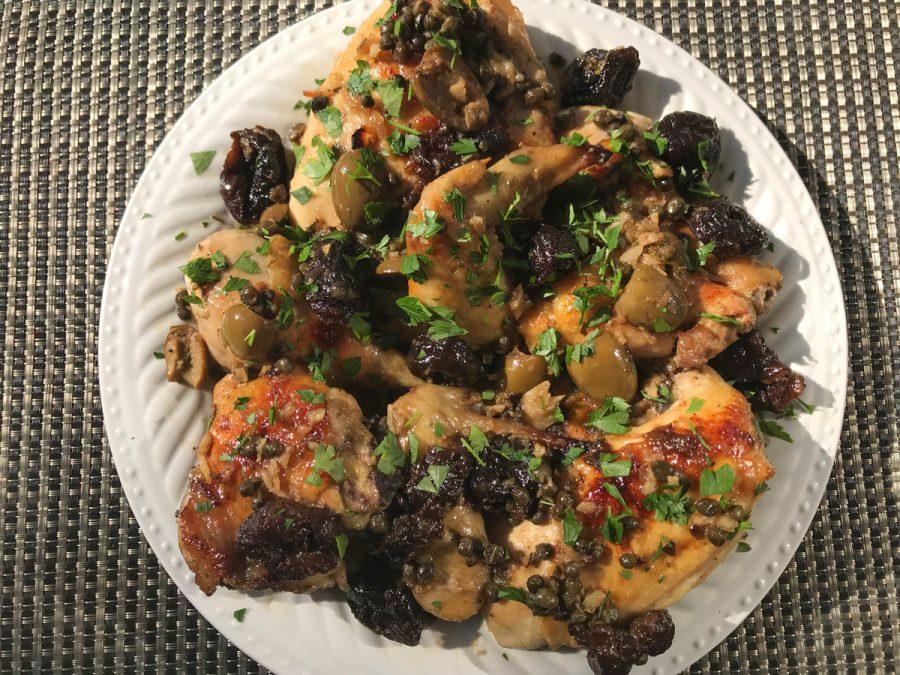Go-to holiday recipes from beloved cookbook
Published August 31, 2018
Culinary traditions and culture are intrinsically linked. Nowhere is this more evident than in the foods we associate with our Jewish holidays. You probably can name several such foods off the top of your head: latkes on Hanukkah, hamentaschen on Purim, matzo ball soup on Passover.
For centuries, Jews have been dispersed throughout the world. And over those centuries, our traditional dishes have been adapted to reflect the accessibility of native ingredients — meats, vegetables, herbs and spices — and often reflect the culinary traditions of the cultures from those parts of the world.
And while we look to Eastern Europe if we are Ashkenazi and the Middle East or Spain if we are Sephardic, we tend to overlook the fact that we are all Americans, and have been Americans for generations.
Which brings me to Chicken Marbella, that iconic Jewish holiday chicken stew laden with prunes, green olives, capers and garlic, second only to brisket as the most popular holiday menu choice of many American Jews.
If you, like me, assumed this dish had its origins in, say, Spain, where Marbella is the name of a coastal town, or somewhere else along the Mediterranean, such as southern France, you would be, as I discovered, wrong. In fact, Chicken Marbella is a classic Jewish American dish that traces its origins back just a half century, to the 1970s, when it was created on the Upper West Side of Manhattan by a Jewish caterer named Sheila Lukins.
If the name Sheila Lukins rings a bell, it might be because she and Julee Rosso are the co-authors of what is generally regarded as the most influential American cookbook since Irma Rombauer’s “The Joy of Cooking.” Indeed, if you are a baby boomer, you probably own a dog-eared, food-stained copy of that marvelous cookbook: “The Silver Palate Cookbook.”
One of the recipes in that cookbook is Chicken Marbella, which had become one of the most popular dishes on the menu of the Silver Palate, which was one of the first gourmet takeout food establishments in New York. Apparently, Lukins had initially created the Silver Palate to cater to single men looking for quality takeout meals, but the word soon spread, as did the clientele.
Chicken Marbella has deep Jewish culinary roots, which draw from Ashkenazi and Sephardic traditions of pairing fruit with meat stews. Two such dishes are tzimmis, an Ashkenazi dish that features flanken, vegetables and prunes, and Moroccan tagine, which features lamb or chicken, dried apricots and prunes.
I know firsthand that Chicken Marbella has become an Jewish American tradition. Specifically, my sister Bobbie Lenga Gutman in Chicago has been serving Chicken Marbella on erev Rosh Hashanah for the past 12 years. As she told me, her guests, who this year will number 28, have come to expect that dish on the menu at her annual holiday gathering.
“Twelve years ago,” she told me, “I bought a special pan just for this chicken, one in which I could both cook and serve the dish. I marinate all the ingredients overnight in a big bowl in the refrigerator. The next afternoon, I dump everything into the special pan, marinade and all, and put it in the oven. It couldn’t be any easier. The enticing aromas that fill the house signal to my family and guests as they arrive that Rosh Hashanah is here.”
My own introduction to Chicken Marbella came 13 years ago at an erev Rosh Hashanah gathering hosted by my machatunim Debby and Art Stengel, whose daughter Amy married my son Jake. Though I had used “The Silver Palate Cookbook”regularly, I somehow never got around to preparing Chicken Marbella. One forkful of this delicious concoction, prepared that night by Debby, made me appreciate the sheer brilliance of that recipe.
Chicken Marbella achieves a delectable balance of sweet and savory. You get plump juicy prunes, meaty green olives, briny capers and oh-so-tender chicken all in one bite. And the mouthwatering sauce, highlighted by the addition of brown sugar and white wine? Don’t think of leaving it behind. Spoon it over your holiday challah (also “The Silver Palate Cookbook”classic recipe I include here — see page 10) for a sweet Rosh Hashanah treat.
Chag Sameach!
Margi Lenga Kahn is the mother of five and grandmother of six. A cooking instructor at the Kitchen Conservatory, she is currently working on a project to preserve the stories and recipes of heritage cooks. She welcomes your comments and suggestions at [email protected].
















